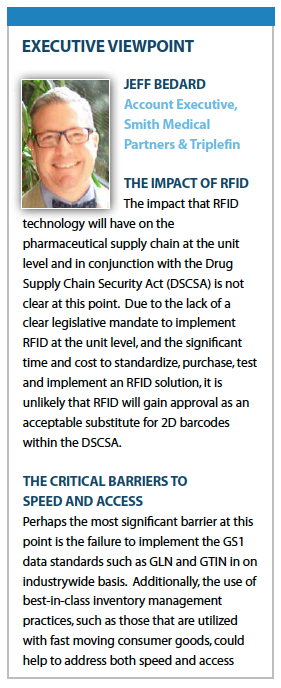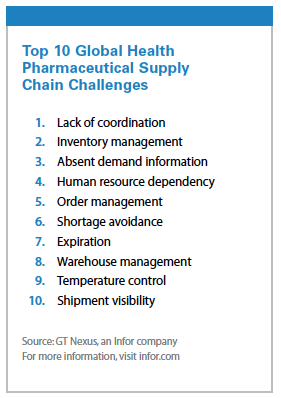 Prepare for impact: The $3 trillion supply chain shakeup is coming, ready or not. Analysts at Accenture say every business is now a digital business. But the question is: is every supply chain a truly digital supply chain? They say many companies are just putting digital processes on top of traditional practices — re-fitting, re-wiring, and re-adapting instead of re-inventing.
Prepare for impact: The $3 trillion supply chain shakeup is coming, ready or not. Analysts at Accenture say every business is now a digital business. But the question is: is every supply chain a truly digital supply chain? They say many companies are just putting digital processes on top of traditional practices — re-fitting, re-wiring, and re-adapting instead of re-inventing.
The increased money companies will make or save through optimized logistics and supply chains is estimated at $3 trillion through 2022.
Accenture outlines four things that a truly digital supply network should be: connected, intelligent, scalable, and rapid.
In terms of being connected, Accenture says systems need to have real-time visibility, seamless collaboration, and operating models that adapt to today’s fickle consumers. In terms of intelligence, they say it’s all about data driving insights, enhancing efficiency, and accelerating innovation. The more integrated, flexible, and personalized the supply chain is, the more scalable it is and, the more companies can take advantage of opportunities. Finally, rapid speed is the currency of the future. And any responsive, proactive company is going to be at an extreme advantage.
According to Accenture, supply chains, both linear and static, are struggling to serve customers whose diverse needs are constantly changing. They say what companies need now to stay competitive in this volatile business environment is a new supply chain strategy — a strategy structured around the flexibility and scalability that digital technologies can enable. With such a strategy, companies can unlock their supply chain to be an engine for growth, enabling quick movement into new geographies, supporting new value-delivery approaches, and creating new products and services.
Coordination to Improve Efficiencies
According to Natalie Privett, assistant professor of management and policy at the Robert F. Wagner Graduate School of Public Service at New York University, and David Gonsalvez, professor of supply chain management at the MIT-Zaragova International Logistics Program, and former global supply chain director with General Motors, the global health pharmaceutical delivery (GHPD) supply chains are wanting. They say the lack of coordination in the GHPD supply chain is an issue whose existence aggravates nearly every other issue directly or indirectly.
Not only do capable supply chains win wars against disease, they are instrumental in winning battles against counterfeit drugs. In 2009, the World Health Organization (WHO) reported that 34 million counterfeit tablets had been taken out of circulation in Europe in just a two-month period.
There are many examples about counterfeit drugs circulating in black market channels and the places in which it is the biggest recurring problem is in the developing world where, in Africa and parts of Asia and Latin America, the proportion of counterfeit medicines has been estimated to be as high as 30%.
 Pharmaceutical companies have to manage incredibly complex supply chains and manage the operational challenges of working and interacting with huge numbers of suppliers contributing ingredients and components to drug production. And now they need to meet track and trace directives and comply with new serialization regulations that require inventory to be auditable as it moves through the supply chain.
Pharmaceutical companies have to manage incredibly complex supply chains and manage the operational challenges of working and interacting with huge numbers of suppliers contributing ingredients and components to drug production. And now they need to meet track and trace directives and comply with new serialization regulations that require inventory to be auditable as it moves through the supply chain.
The two experts say companies coming to grips with serialization should consider if their existing supply chain management systems and processes provide:
1. Accurate information across the entire chain at any point and at any location.
2. Instant access to real-time updates and alerts if issues are detected.
3. Visibility of all handovers in the supply chain.
4. Traceability back to source of all materials.
5. Seamless collaboration between all parties.
They add that traditional ERP systems do not provide a holistic and complete view of the production and movement of goods from start to finish that is now needed. With these traditional models, each link in the supply chain has its own systems that often cannot connect into each other so the level of visibility so desperately sought is difficult, if not impossible, to achieve. Networking suppliers, partners, and logistics providers along the supply chain can offer a more comprehensive view of activities. Organizations need a collaborative system that is equipped with reliable information throughout the supply chain. The first step toward achieving the directives of track and trace and serialization is to improve visibility throughout the supply chain. Until a company can see all the activity taking place among its suppliers, shippers, vendors, and partners, it’ll struggle to prevent leaks in supply chain and — importantly — have a hard time showing regulators they’re following the rules.
A cloud-based supply chain management platform offers visibility to all companies, regardless of size. For a large, multinational pharma business, access to data from all operational regions allows for greater awareness of growth areas, understanding of where hold-ups might exist in the supply chain, and insight into how these might be navigated in order to avoid impact on distribution. And crucially, this can help track and trace via serialization.
PwC analysts say as scientific advances enable the industry to move from a one-size-fits-all approach to care to one of segmentation, personalization and wellness, the supply chain will need to evolve. The supply chain of the future will be built around flexibility, responsiveness, and reliability shifting the supply paradigm from a stock-based model to an order-based model. Its characteristics will include: techniques to rapidly commission and decommission new products and markets; alternate supply models to match shifts in the provision of care; advanced product design and packaging to both drive patient compliance and protect intellectual property. Inventory tracking tools will need to eliminate counterfeiting and parallel-importing risks. (PV)


















